Our verdict
- Top pick in best winter running shoes (2023)
- Top pick in best waterproof running shoes (2024)
Pros
- Versatile road-to-trail performance
- Grippier than the standard version
- Surprisingly light for a GTX shoe
- Accommodates wide feet with ease
- Delivers a really stable ride for neutral runners
- Upper showcases remarkable durability
- Fantastic option for heel strikers
Cons
- Non-gusseted tongue allows water and debris to enter the shoe
- Not suitable for technical terrain
- Excessive drop for midfoot or forefoot strikers
Audience verdict
- Top 28% in Gore-Tex running shoes
Comparison
The most similar running shoes compared
+ + Add a shoe | |||||
|---|---|---|---|---|---|
| Audience score | 86 Good! | 76 Decent! | 81 Good! | 87 Great! | |
| Price | £145 | £145 | £170 | £160 | |
| Trail terrain | LightModerate | Light | ModerateTechnical | Technical | |
| Shock absorption | - | Moderate | - | - | |
| Energy return | - | Moderate | - | - | |
| Arch support | Neutral | Neutral | Neutral | Neutral | |
| Weight lab Weight brand | 9.6 oz / 271g 9.6 oz / 272g | 9.9 oz / 281g 10.6 oz / 300g | 10.4 oz / 296g 10.7 oz / 303g | 11.5 oz / 325g 11.6 oz / 328g | |
| Drop lab Drop brand | 12.8 mm 10.0 mm | 8.3 mm 9.5 mm | 11.6 mm 6.0 mm | 11.2 mm 10.0 mm | |
| Strike pattern | Heel | HeelMid/forefoot | Heel | Heel | |
| Size | Slightly small | Slightly small | True to size | True to size | |
| Midsole softness | Soft | Soft | Balanced | Firm | |
| Difference in midsole softness in cold | Small | Normal | Small | Small | |
| Plate | ✗ | ✗ | Rock plate | ✗ | |
| Toebox durability | Good | Decent | Good | Good | |
| Heel padding durability | Good | Bad | Bad | Good | |
| Outsole durability | Good | Good | Decent | Decent | |
| Breathability | Warm | Warm | Warm | Warm | |
| Width / fit | Medium | Medium | Narrow | Medium | |
| Toebox width | Wide | Wide | Medium | Medium | |
| Stiffness | Stiff | Moderate | Stiff | Stiff | |
| Torsional rigidity | Stiff | Stiff | Stiff | Stiff | |
| Heel counter stiffness | Flexible | Flexible | Stiff | Stiff | |
| Lug depth | 3.5 mm | 3.6 mm | 4.4 mm | 5.0 mm | |
| Heel stack lab Heel stack brand | 37.7 mm 37.0 mm | 32.1 mm 37.0 mm | 37.3 mm 39.0 mm | 37.0 mm 32.0 mm | |
| Forefoot lab Forefoot brand | 24.9 mm 27.0 mm | 23.8 mm 27.5 mm | 25.7 mm 33.0 mm | 25.8 mm 22.0 mm | |
| Widths available | Normal | NarrowNormal | Normal | Normal | |
| Season | Winter | Winter | Winter | Winter | |
| Removable insole | ✓ | ✓ | ✓ | ✓ | |
| Orthotic friendly | ✓ | ✓ | ✓ | ✓ | |
| Waterproofing | Waterproof | Waterproof | Waterproof | Waterproof | |
| Ranking | #379 Bottom 43% | #356 Bottom 5% | #305 Bottom 19% | #159 Top 43% | |
| Popularity | #374 Bottom 43% | #107 Top 29% | #239 Bottom 36% | #149 Top 40% |
Who should buy
We believe the GTX version of the Pegasus Trail 4 is an excellent choice for:
- Just about anyone looking for a light, waterproof running shoe that can handle easy-to-moderate trails with ease.
- Fans of the Pegasus Trail series who desire a GTX version for rainy days or winter training sessions.
- Heel strikers seeking a versatile, road-to-trail shoe that's equipped with Gore-Tex technology for all-weather performance.
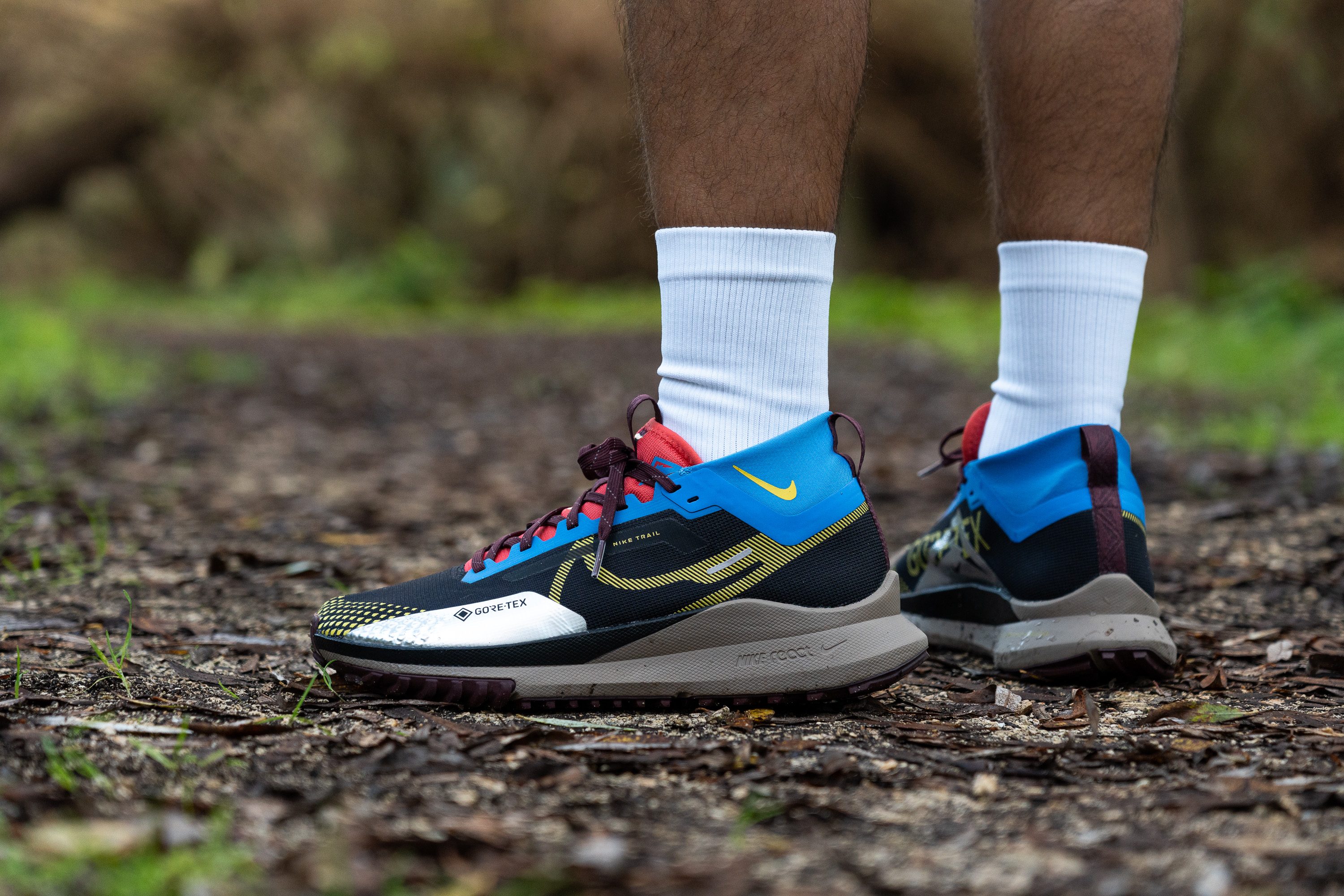
Who should NOT buy
The Pegasus Trail 4 GTX is a great trail shoe, yet our belief is that it's not the best fit for challenging or technical terrains. It's just more suited for less demanding scenarios. For tackling tougher trails and wild adventures, consider the Salomon Speedcross 6 GTX instead.
Also, it's not our top pick for primarily road running, especially if you're a midfoot or forefoot striker. The Hoka Clifton 9 GTX, while capable on easy trails, performs better on asphalt.
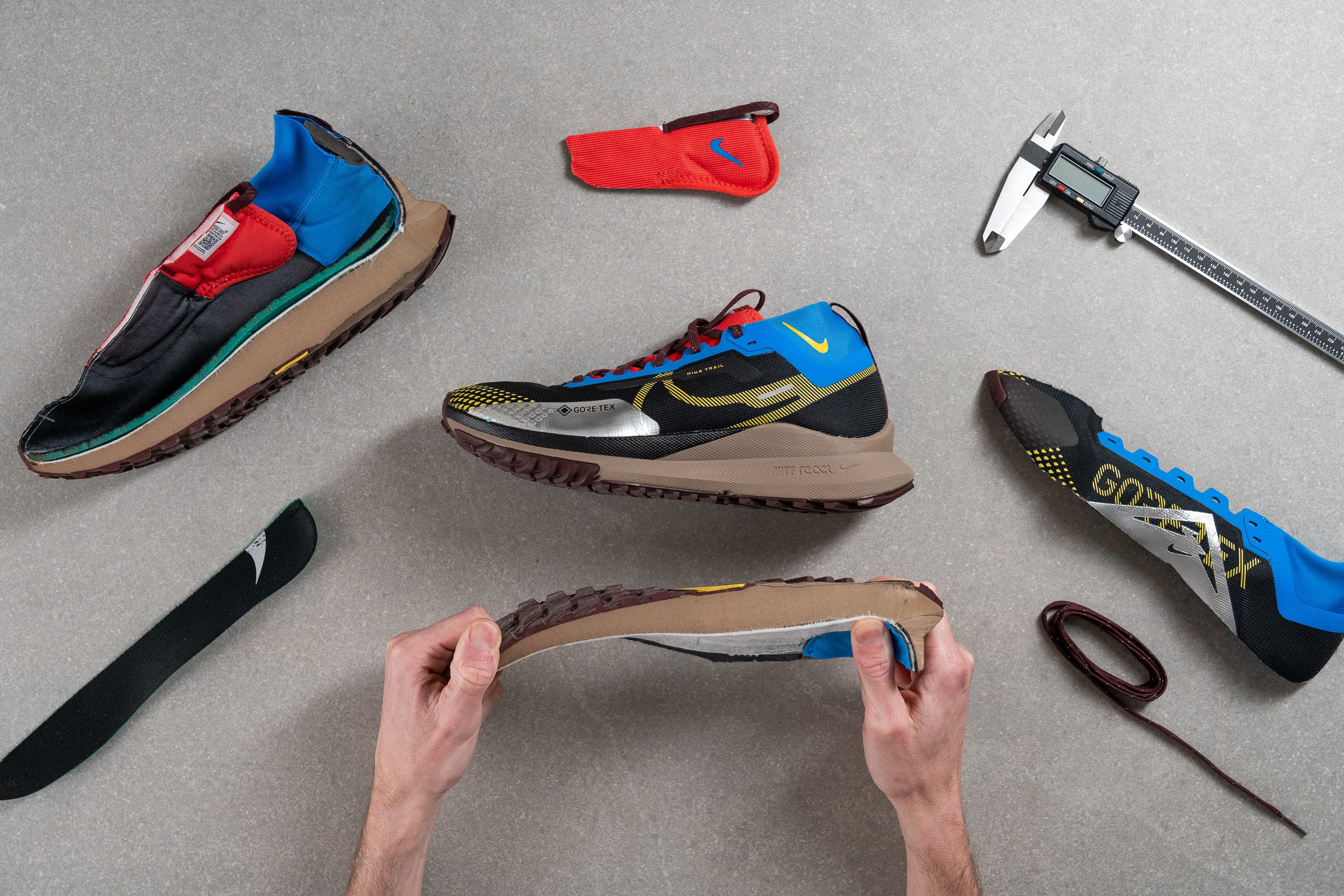
Cushioning
Heel stack
And no, the weight savings don't come from skimping on the React midsole. In fact, at 37.7 mm, there are few trail running shoes more generously stacked than the Peg Trail 4 GTX.
This ensures ample cushioning for long runs if needed, even for the heaviest heel strikers out there.
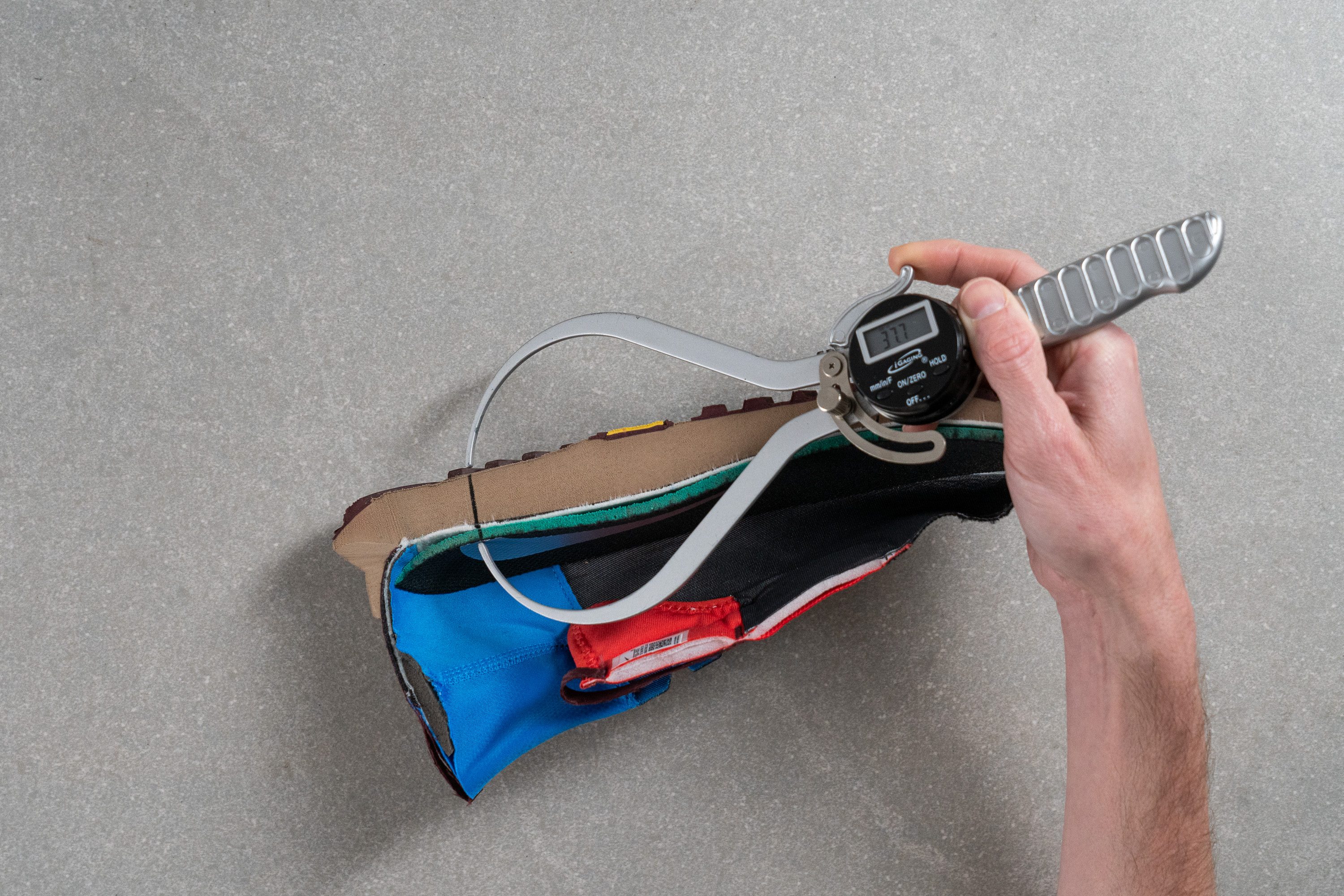
| Pegasus Trail 4 GTX | 37.7 mm |
| Average | 32.6 mm |
Forefoot stack
In contrast, the forefoot is average at 24.9 mm, which we anticipated in the lab because the Pegasus line has always featured a high drop. Let's take a closer look at that.
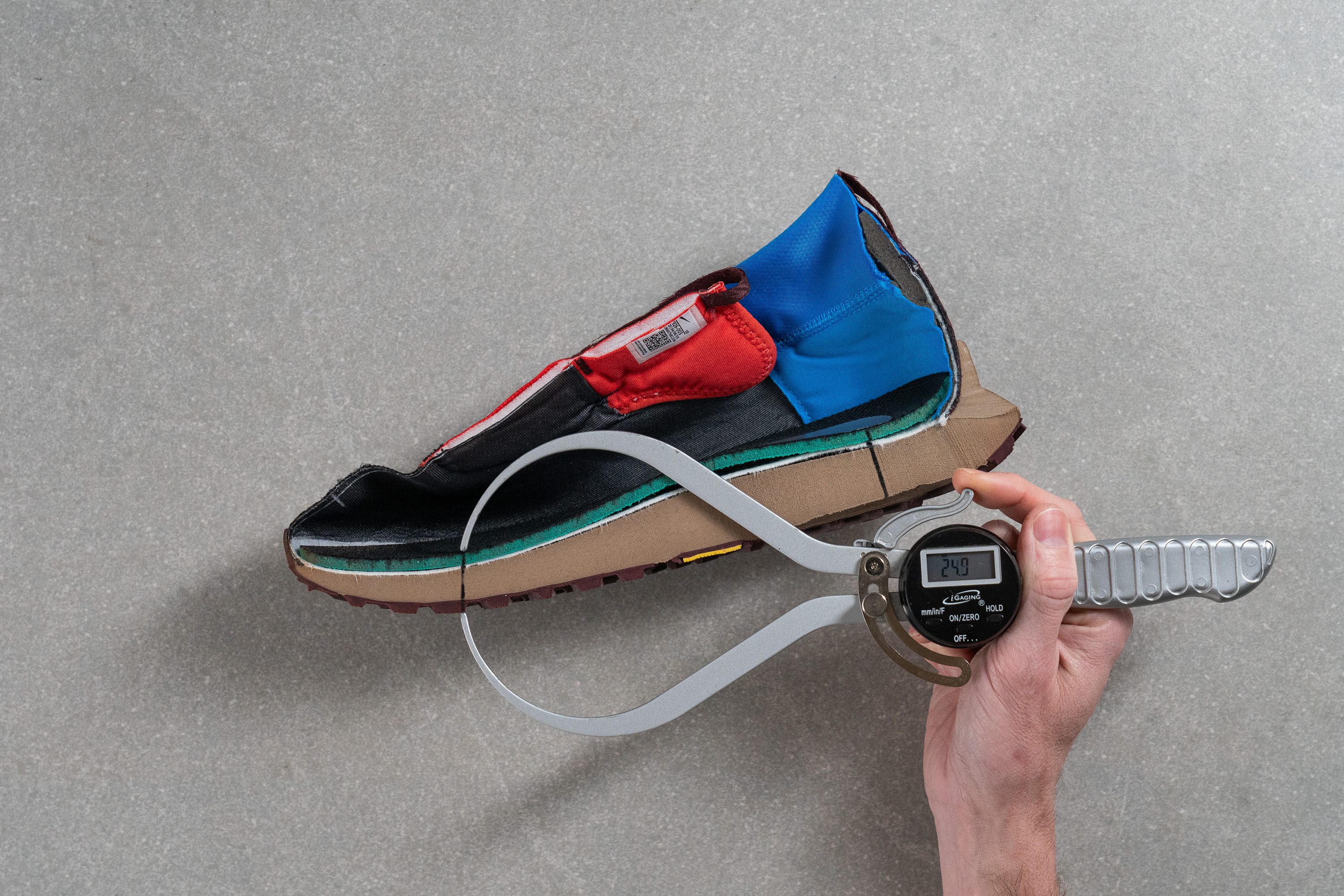
| Pegasus Trail 4 GTX | 24.9 mm |
| Average | 25.1 mm |
Drop
Here it is. With a 12.8-mm drop, this shoe is a delight for those who thrive in high-drop shoes, like extreme heel strikers or those needing to ease the strain on their calves and Achilles in every run.
However, it's not the best trail shoe for forefoot or midfoot strikers. You won't benefit from the shoe's wedge-shaped geometry, and you'll likely struggle on technical terrain. If you fall into that category, you're better off with a shoe with a lower offset, like the Hoka Speedgoat 5 GTX.
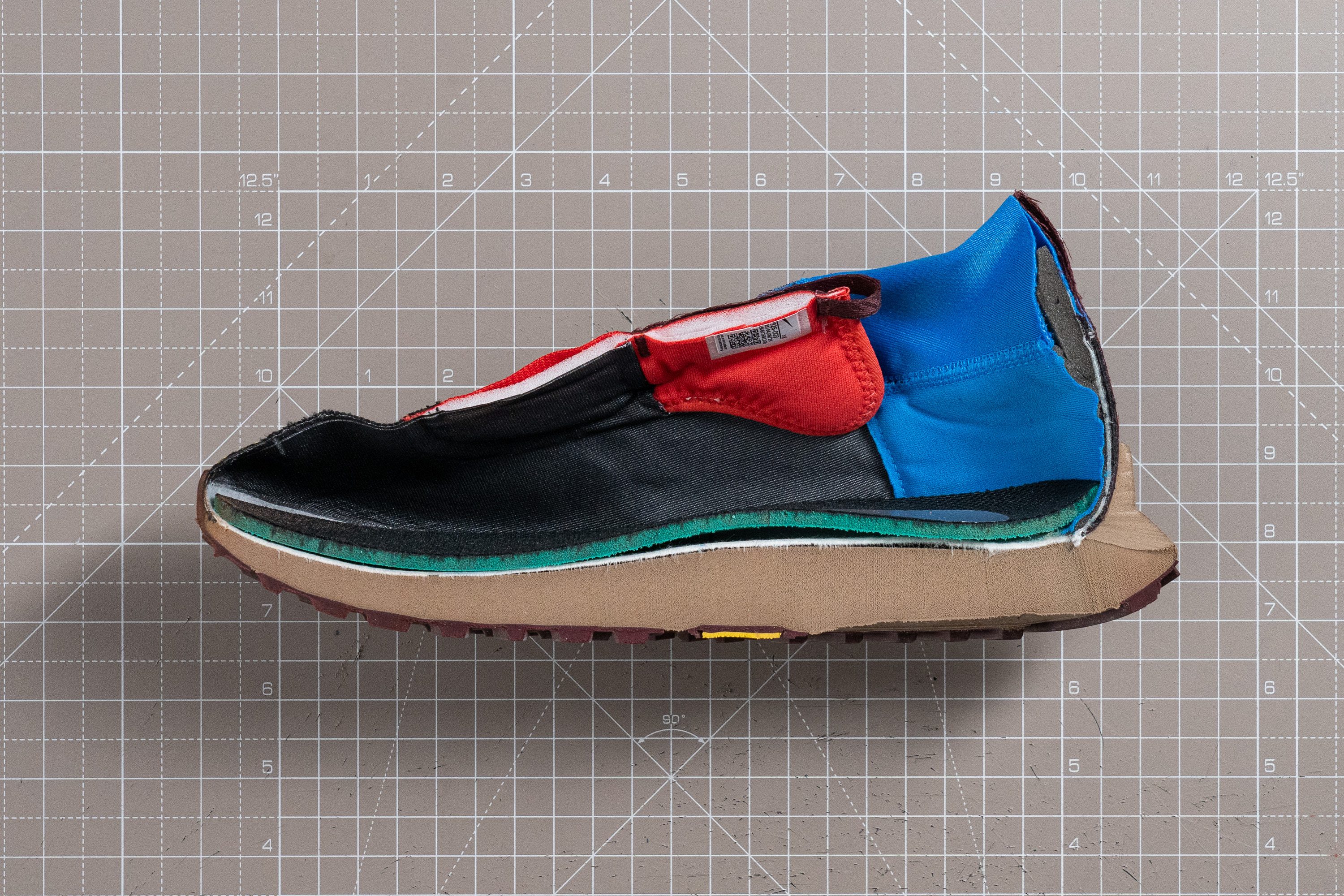
| Pegasus Trail 4 GTX | 12.8 mm |
| Average | 7.5 mm |
Midsole softness
Nike has employed its tried-and-true React midsole in the Pegasus Trail 4 GTX, aiming for a perfect balance between stability and comfort, and the foam truly delivers in that respect.
React might not be Nike's most advanced foam—it's ZoomX—but it performs its job exceptionally well, standing far ahead of many other middle-of-the-pack foams in terms of energy return. We really liked it!
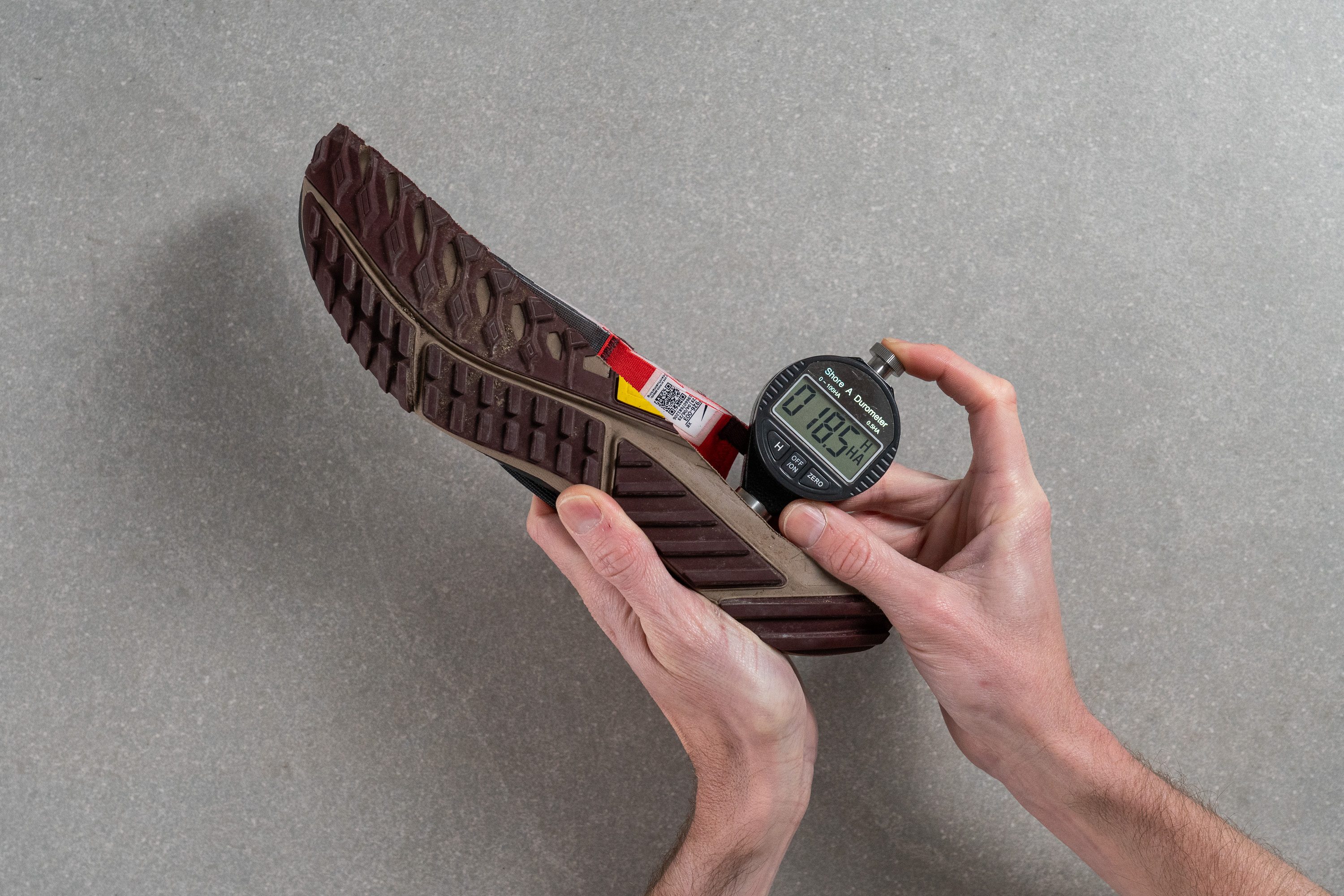
| Pegasus Trail 4 GTX | 18.6 HA |
| Average | 21.9 HA |
Size and fit
Size
Nike Pegasus Trail 4 GTX fits slightly small (290 votes).
Internal length
| Pegasus Trail 4 GTX | 269.0 mm |
| Average | 269.0 mm |
Width / Fit
Another common critique of Nike shoes is their snug fit. But that's not an issue with the Pegasus Trail 4 GTX.
We measured the widest part of the upper at an impressive 97.7 mm, wider than average but still considered medium.

| Pegasus Trail 4 GTX | 97.7 mm |
| Average | 95.6 mm |
Toebox width
We confidently recommend the Pegasus Trail 4 GTX for runners who prefer or require a broader toebox.
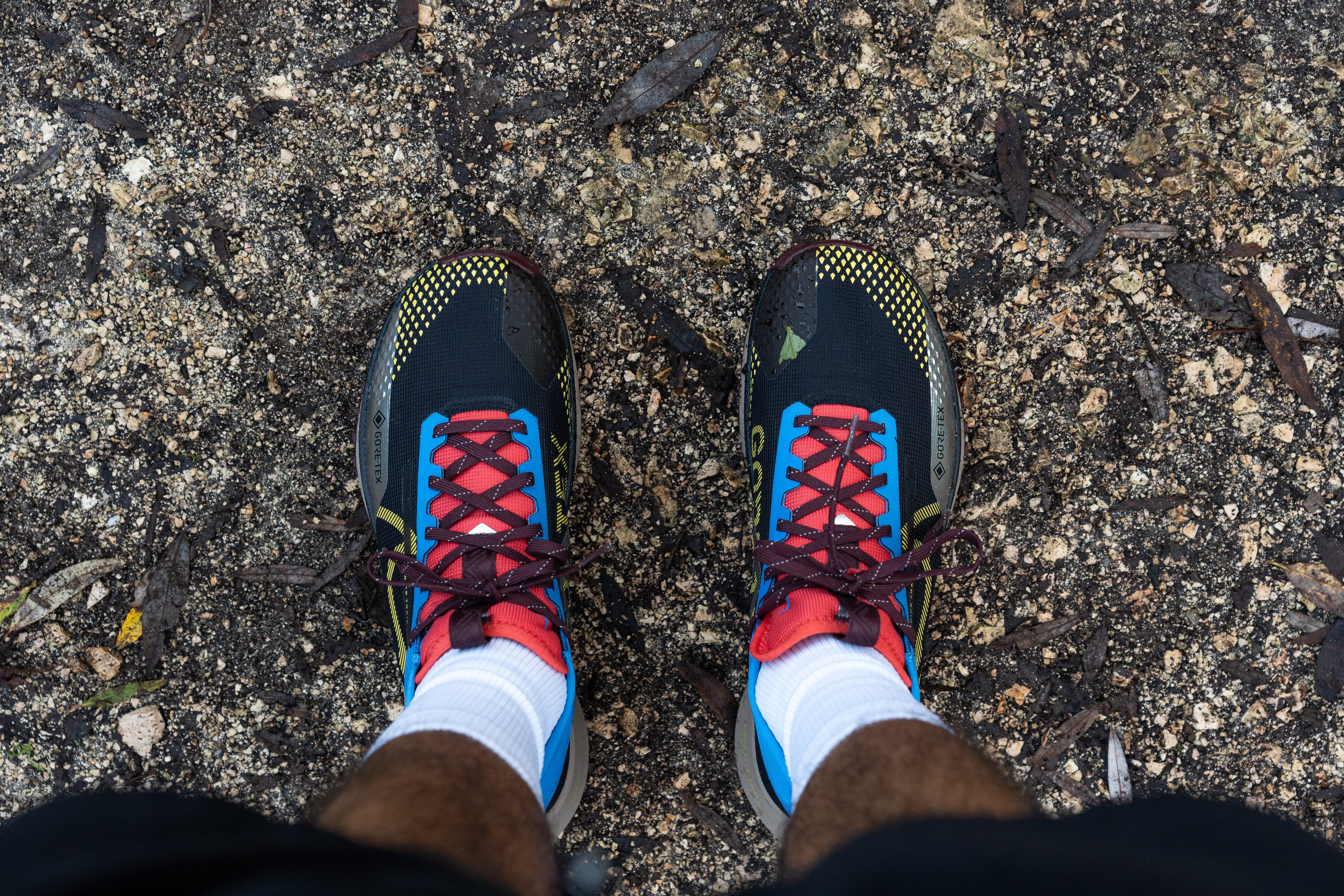
Measuring 77.3 mm in the big toe area on our gel mould of the shoe's interiors, it showcases an impressively open and accommodating design.
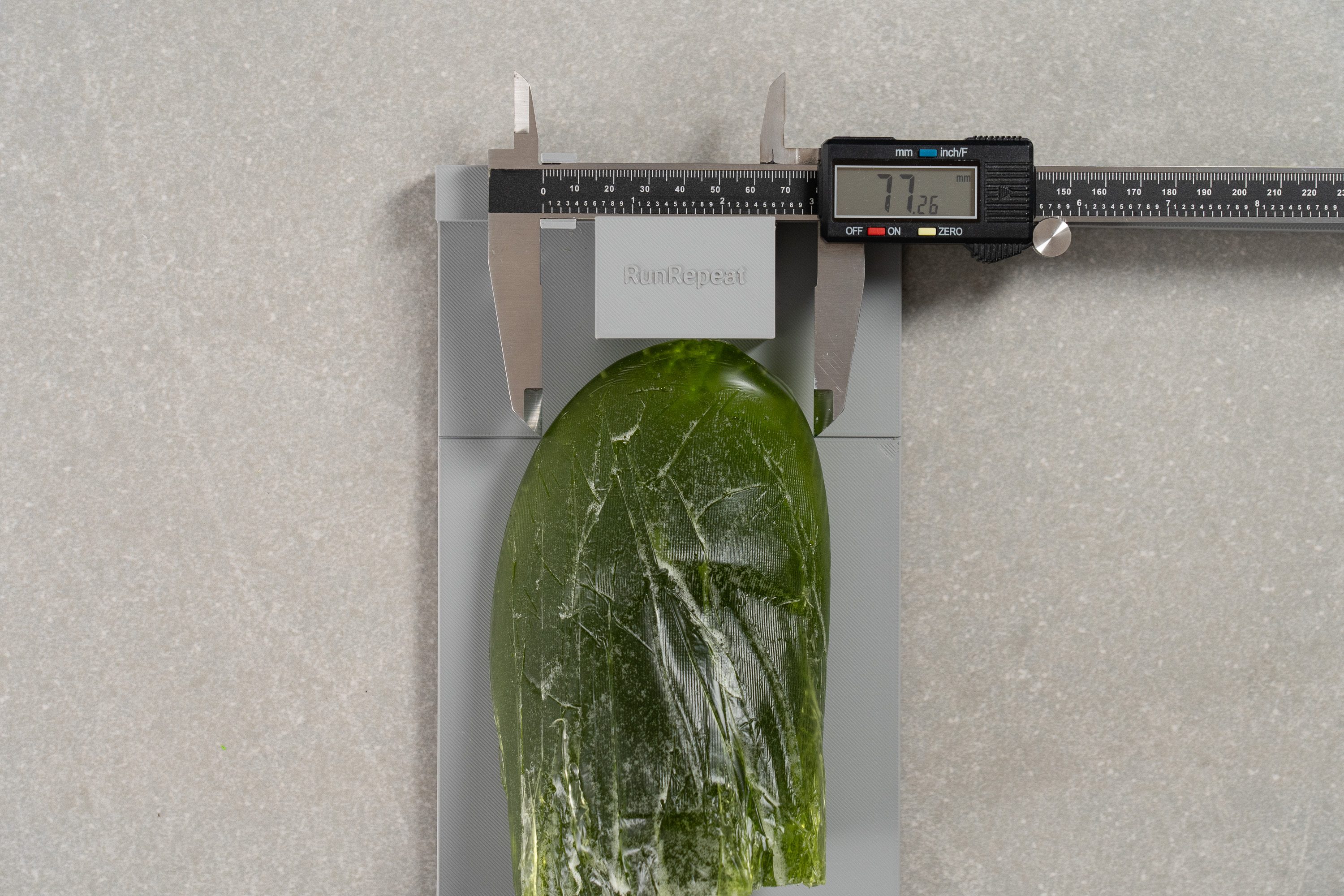
| Pegasus Trail 4 GTX | 77.3 mm |
| Average | 74.6 mm |
Toebox height
The upper provides ample space for lateral toe movement, but vertical room is limited. Our measurement came in at just 25.2 mm—well below the average.
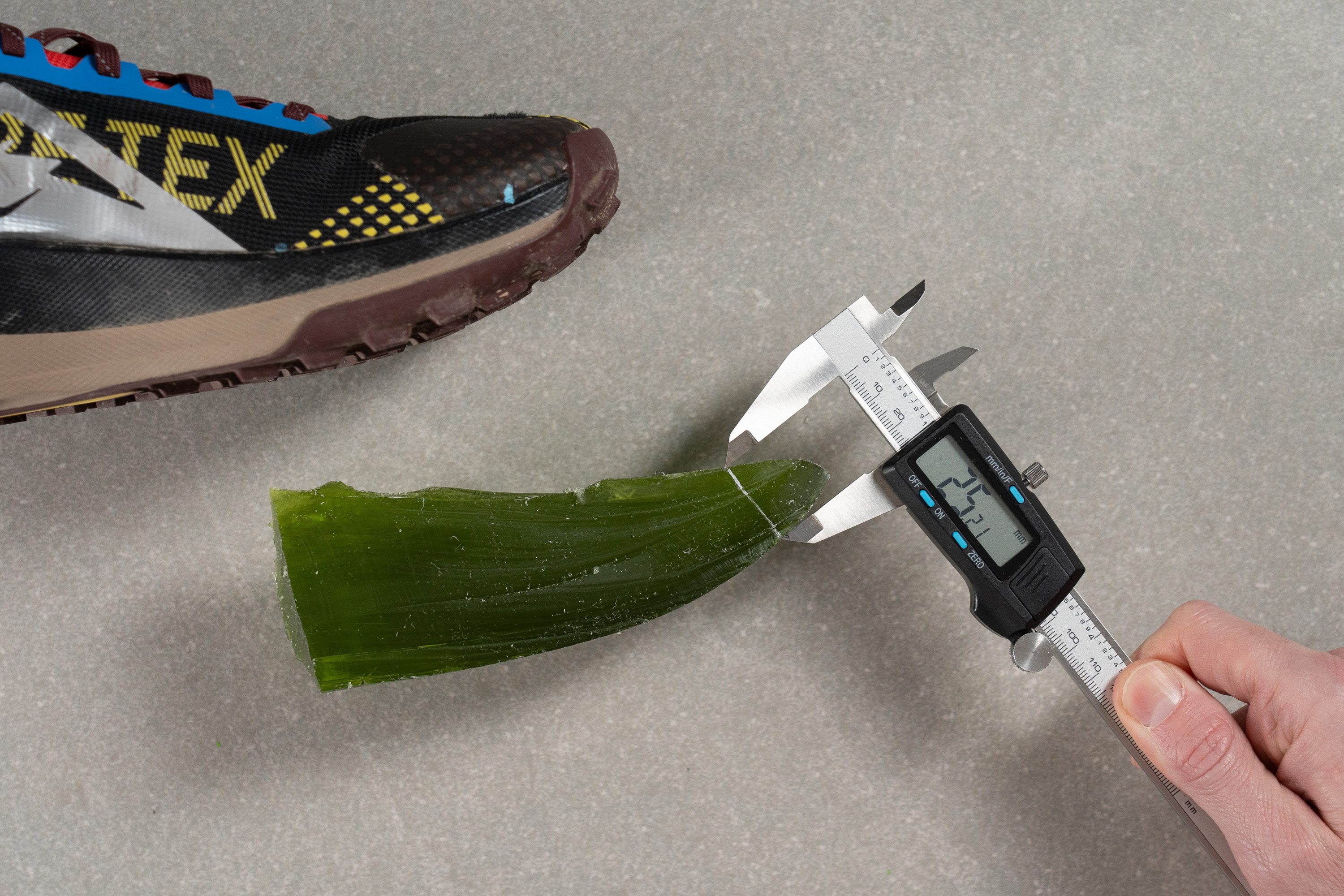
| Pegasus Trail 4 GTX | 25.2 mm |
| Average | 27.1 mm |
Traction / Grip
Lug depth
One of the major criticisms the Pegasus Trail series has faced over time is its grip on wet surfaces, a crucial aspect for a GTX shoe. That's why Nike introduced a new rubber formulated for wet conditions and a redesigned outsole.
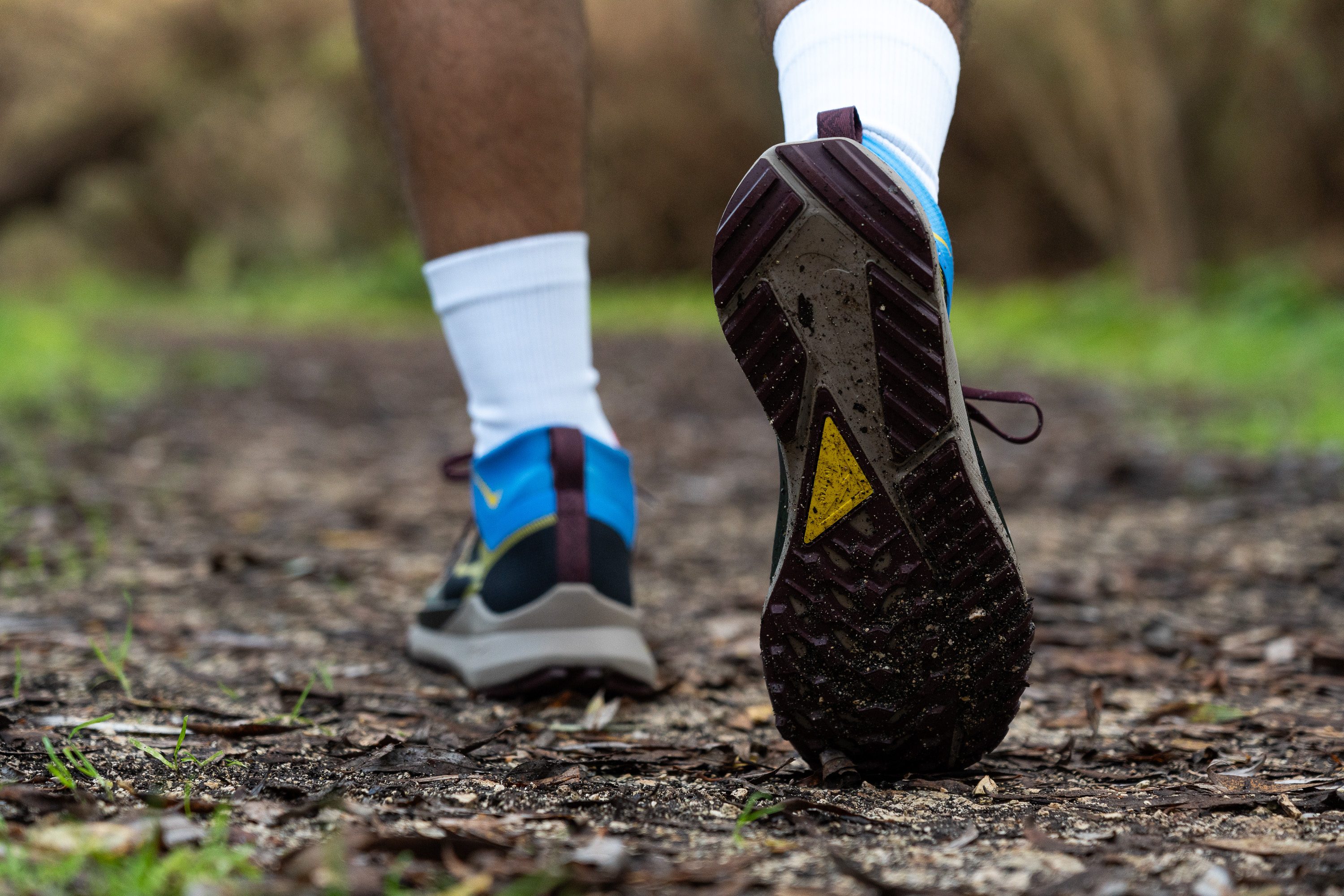
The new outsole design features a wide variety of 3.5-mm lug shapes, each tailored to handle different terrains and situations, like uphill running, downhill, or taking corners.
We must say, while it's still not quite on par with a Vibram outsole, Nike is definitely stepping up their game!
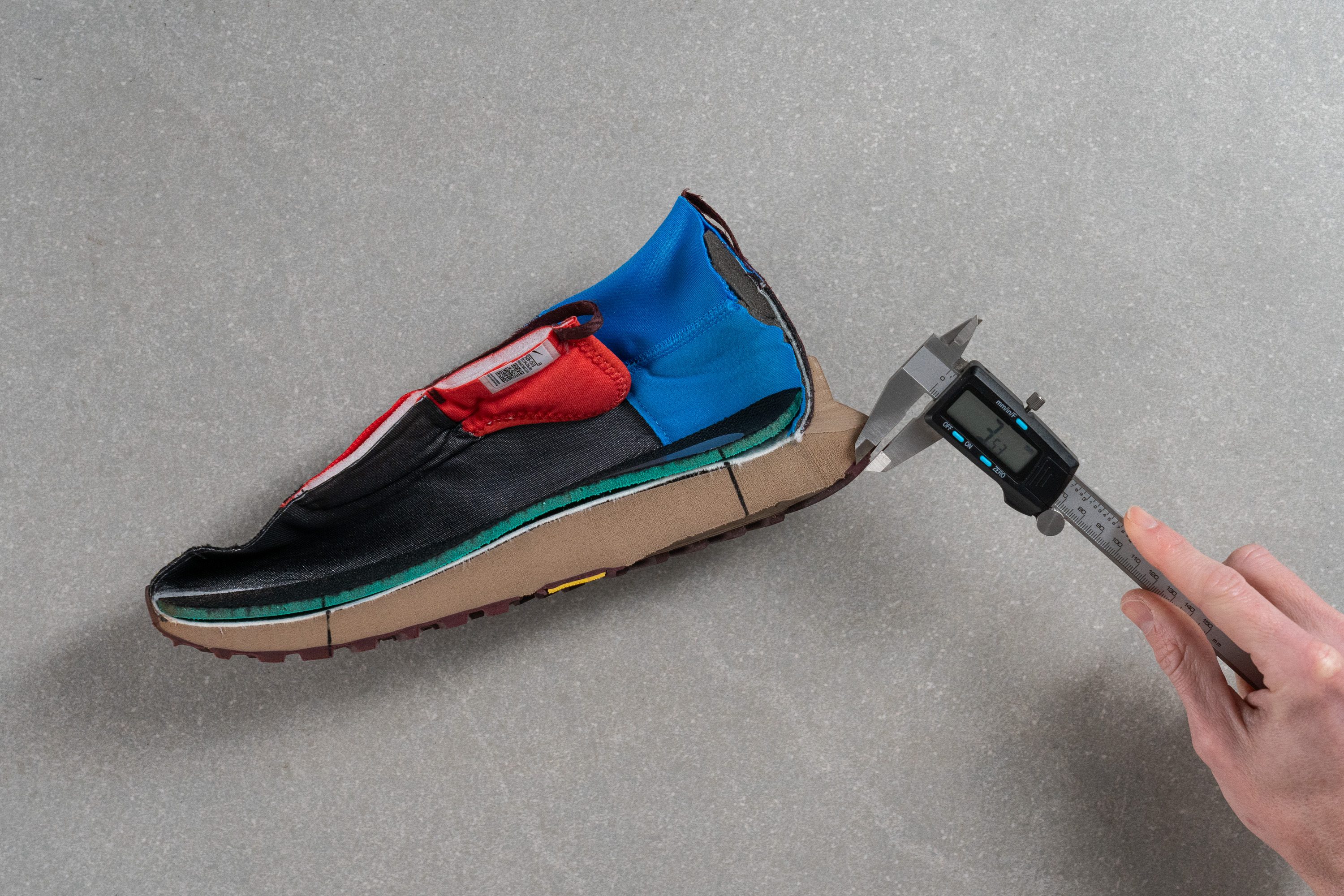
| Pegasus Trail 4 GTX | 3.5 mm |
| Average | 3.5 mm |
Flexibility / Stiffness
We know many runners use their Pegasus Trail 4 for everyday wear and even as their go-to shoe for traveling, thanks to its incredible versatility in handling both road and trails—making it the ultimate choice for light packing.

With that in mind, Nike continues to deliver a flexible shoe that only required 21.1N of effort from us to bend it to 90 degrees, making it exceptionally comfortable!
This test follows an older methodology, which is why you don't see recently tested shoes in the chart. Results from different methodologies can not be compared.
| Pegasus Trail 4 GTX | 21.1N |
| Average | 27.1N |
Stiffness in cold
When exposed to cold temperatures, the shoe underwent a slight change.
After spending another 20 minutes in our freezer, we re-tested it and recorded a higher result at 26.5N.
| Pegasus Trail 4 GTX | 26.5N |
| Average | 35.9N |
Stiffness in cold (%)
We believe most runners won't notice this change. It's just a 25.3% difference.
| Pegasus Trail 4 GTX | 25% |
| Average | 32% |
Weight
Weighing in at just 9.6 oz (271g), we're absolutely amazed at how Nike managed to deliver a Gore-Tex shoe that weighs the same as the regular version. In our lab experience, most shoes gain between 0.5 to 1 ounce with the addition of the GTX membrane, so this was a delightful surprise.
And the shoe indeed feels incredibly light, staying under the 10-oz benchmark. It's not just suitable for slow efforts but also performs brilliantly at faster paces.
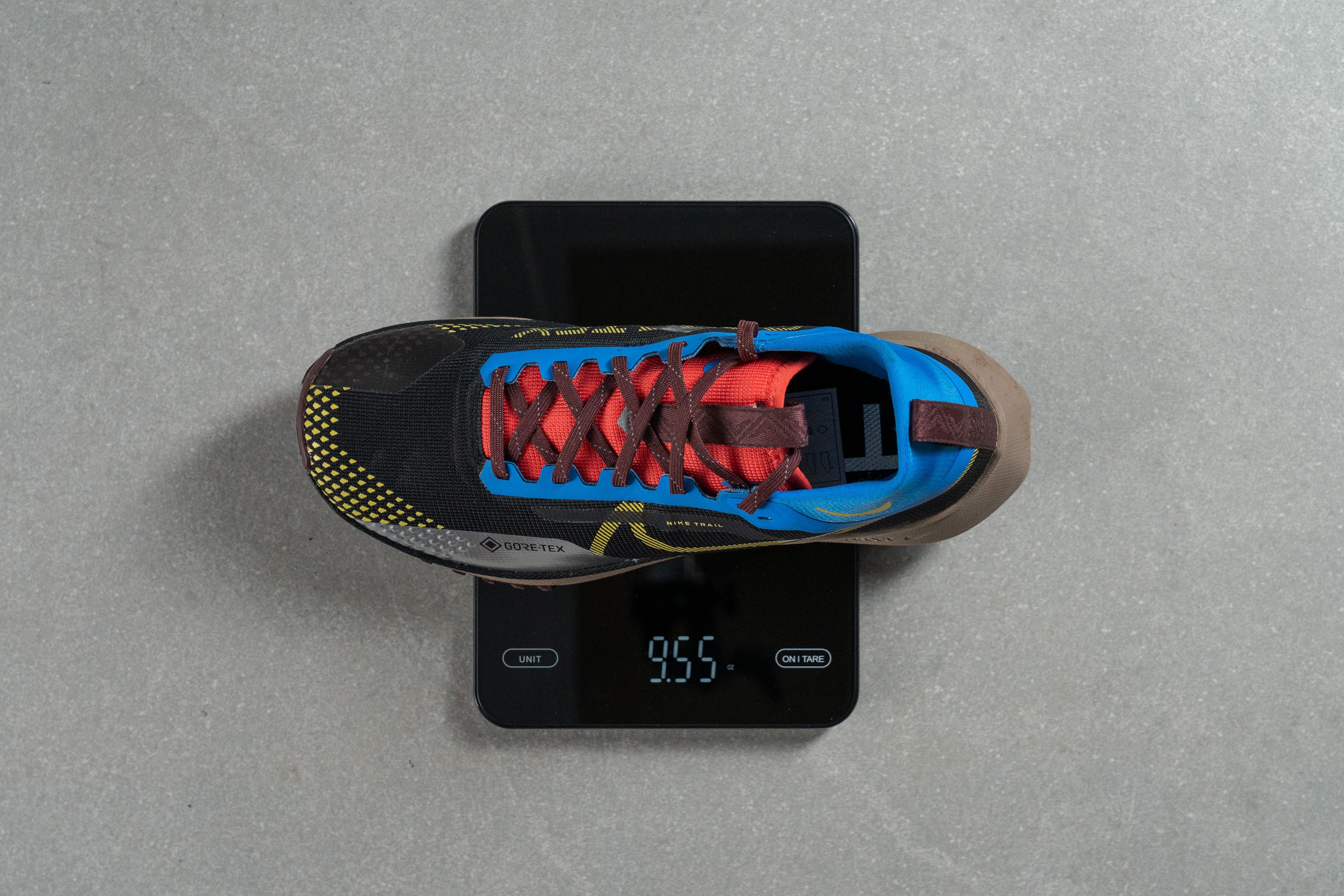
| Pegasus Trail 4 GTX | 9.6 oz (271g) |
| Average | 10.2 oz (289g) |
Breathability
In our lab tests with Gore-Tex shoes, we usually expect a low breathability score—typically a 1 out of 5. However, the Pegasus Trail 4 GTX surprised us with a slightly better score of 2 out of 5. This is probably fine for trail running as long as you avoid the hottest days of the year.
The minimal breathability is mainly through the tongue, as the Gore-Tex upper almost completely blocks airflow, even though it's supposed to let some air in.
To confirm this, we shone our powerful light directly into the cut-in-half upper. As we anticipated, no light penetrated through.
Still wanting more evidence, we turned to our microscope.
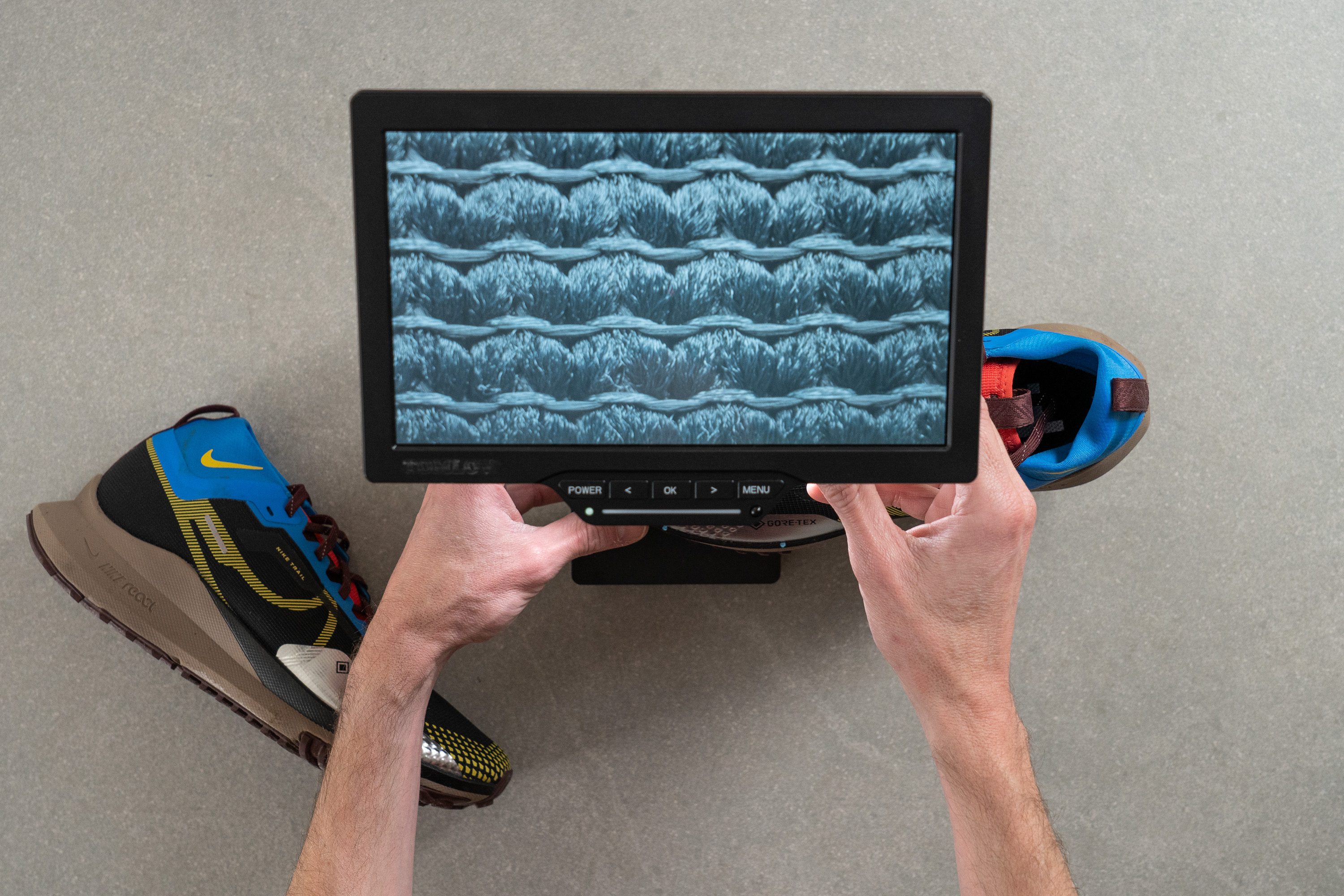
There, we discovered a thick mesh that confirmed the lack of airflow throughout the entire upper, except for the upper parts of the tongue. Everything is sealed.
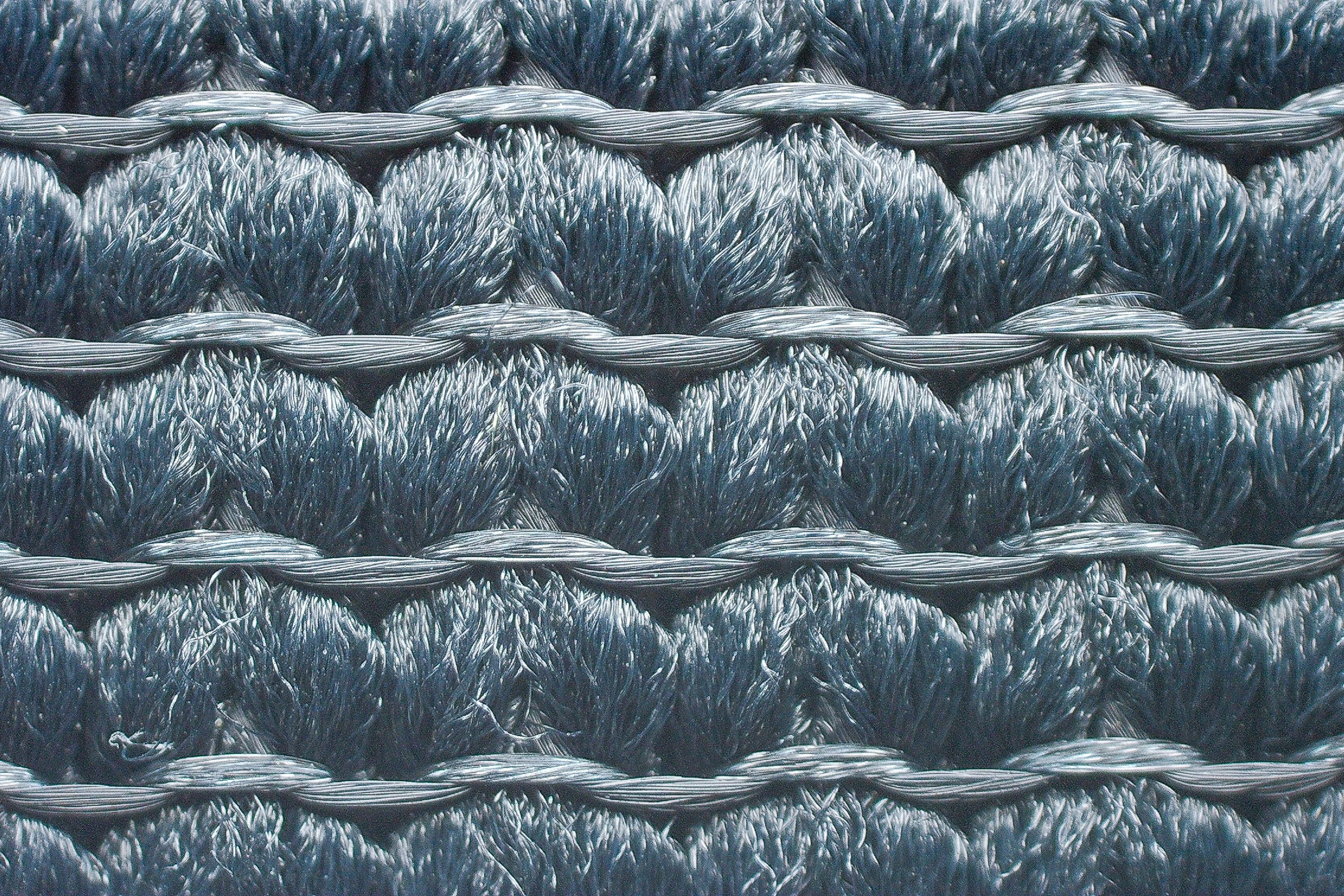
Lastly, we manually assessed the upper and found it super dense, with almost no stretch potential. But it also appeared really sturdy, which made us eager to test its durability in the lab.
| Pegasus Trail 4 GTX | 2 |
| Average | 3.2 |
Stability
The outsole might look thin at just 1.0 mm, but it's not a worry for us.
The lugs contribute a substantial amount of rubber and offer average durability, as we've demonstrated before. So, the blend of the outsole and the lugs will definitely provide more than enough durability across all terrains, including roads.
Lateral stability test
As a Pegasus model, this shoe is designed for neutral runners who don't require specific stability features like medial posts or guidance.
Yet, its performance is nothing short of miraculous in this aspect, offering a ride that's consistently stable on buffed trails, leading us to believe it could also suit slight pronators if necessary.
Torsional rigidity
We discovered in our tests that one of the main reasons for the shoe's impressive stability is its torsional rigidity.
When we manually assessed it, we found it's as rigid—scoring 4 out of 5—as trail shoes that have carbon plates like the Saucony Endorphin Edge, even though this one doesn't.
| Pegasus Trail 4 GTX | 4 |
| Average | 3.6 |
Heel counter stiffness
In stark contrast, Nike aimed for maximum comfort in the heel area, so we found the heel counter to be extremely flexible and adaptable.
This is great news, especially for runners with Haglund's deformity, who often struggle with a stiff heel counter.
| Pegasus Trail 4 GTX | 2 |
| Average | 3 |
Midsole width - forefoot
The Pegasus saga has always been like the average Joe of shoes, and Nike's designers stuck to that winning formula with the shoe's dimensions. We measured the forefoot and got 111.6 mm, which is... yeah, you guessed it, just average!

| Pegasus Trail 4 GTX | 111.6 mm |
| Average | 112.8 mm |
Midsole width - heel
The forefoot is also pretty similar to the average (88.5 mm), with nothing significant to note. The big risk here could have been a too narrow heel, which would have caused trouble for heel strikers, since this shoe is designed for them. However, it's all good!
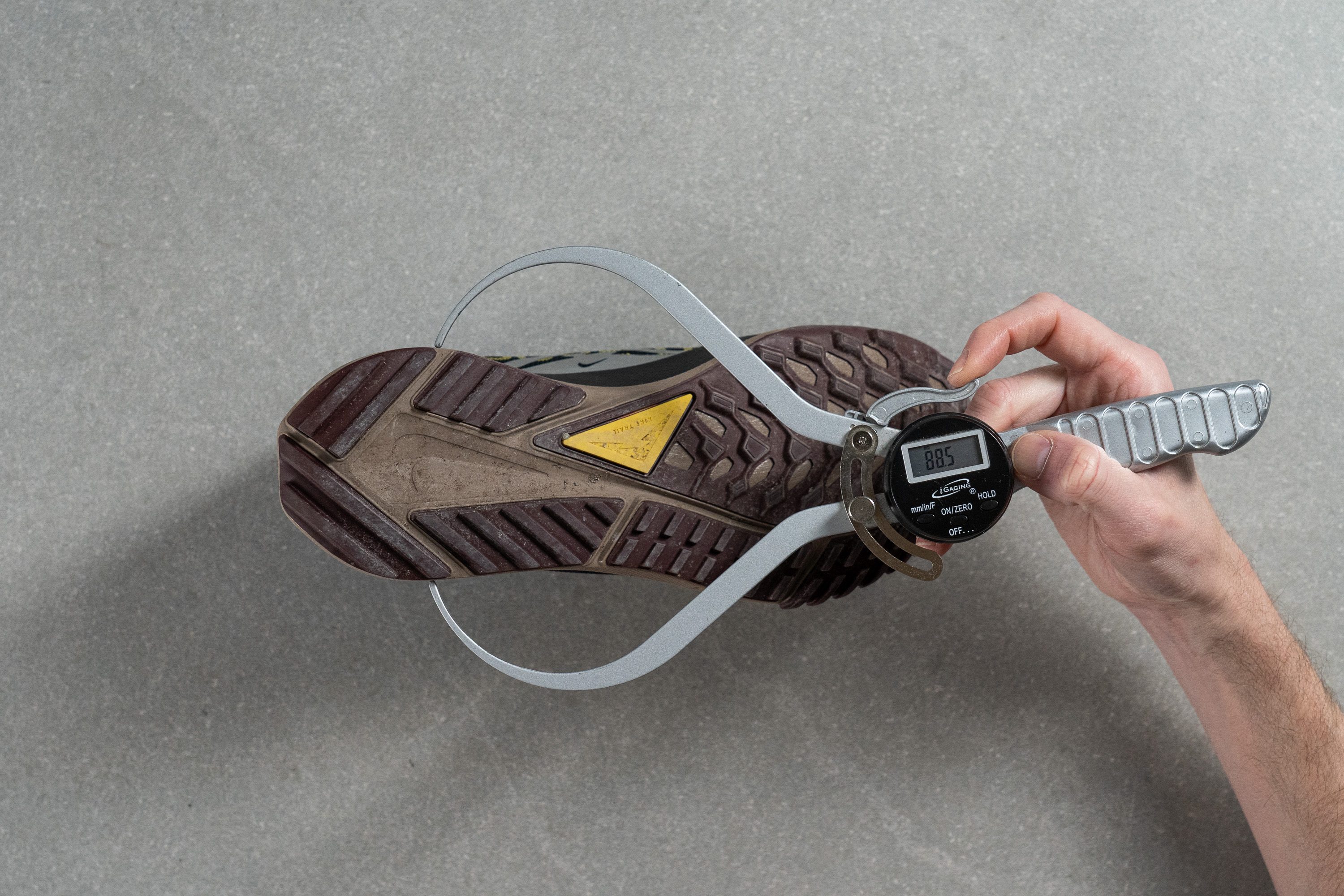
| Pegasus Trail 4 GTX | 88.5 mm |
| Average | 89.9 mm |
Durability
Toebox durability
Nike has included several TPU protective overlays in the upper to enhance protection and prevent damage, yet we tested it by applying the Dremel directly on the engineered mesh.
The Peg Trail 4 GTX scored an impressive 4 out of 5, a remarkable outcome few shoes achieve in this rigorous test.

| Pegasus Trail 4 GTX | 4 |
| Average | 3.1 |
Heel padding durability
Next, we again used the Dremel, but this time to test the heel area of the shoe.
There, we noticed slightly less padding than what's typical in training shoes, a factor that we believe contributed to the fantastic 5 out of 5 score this variant of the Pegasus Trail 4 achieved.

| Pegasus Trail 4 GTX | 5 |
| Average | 3 |
Outsole hardness
Moving to the outsole, the Pegasus saga—like with the regular Pegasus 40—has always prioritised durability over grip.
With our 89.0-HC measurement from our durometer, it seems Nike is continuing on the same path.
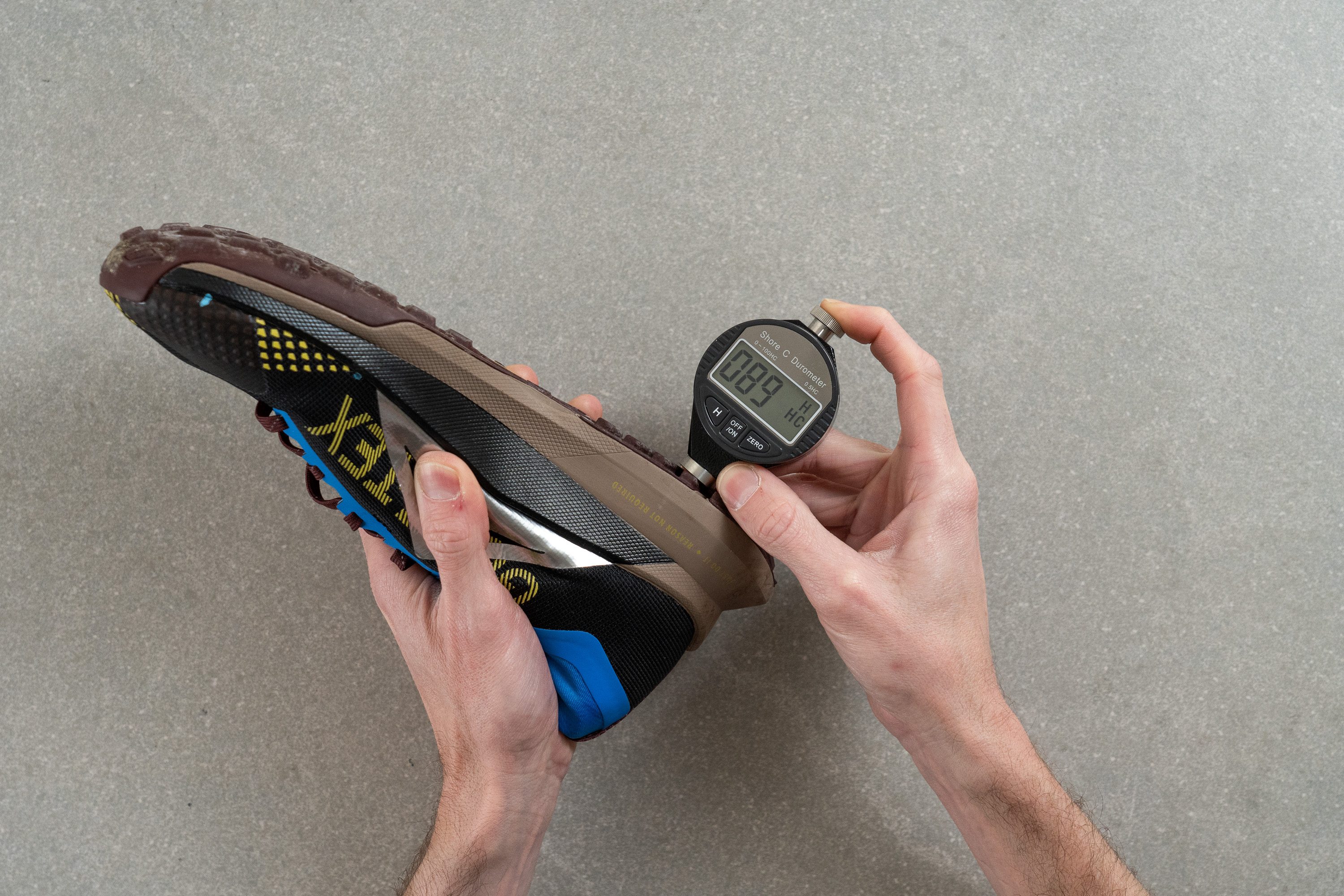
| Pegasus Trail 4 GTX | 89.0 HC |
| Average | 85.8 HC |
Outsole durability
Given the hard rubber it packs, we had high expectations for our last Dremel test in the lab, this time with a new formula designed for wet or loose surfaces.
We must say, Nike really delivered this time, shaking off their reputation for crafting subpar outsoles for rainy days. This one is grippier than ever.
Moreover, it proved to be durable. We only found a 0.8-mm indentation in the rubber, which is a great result in this evaluation.
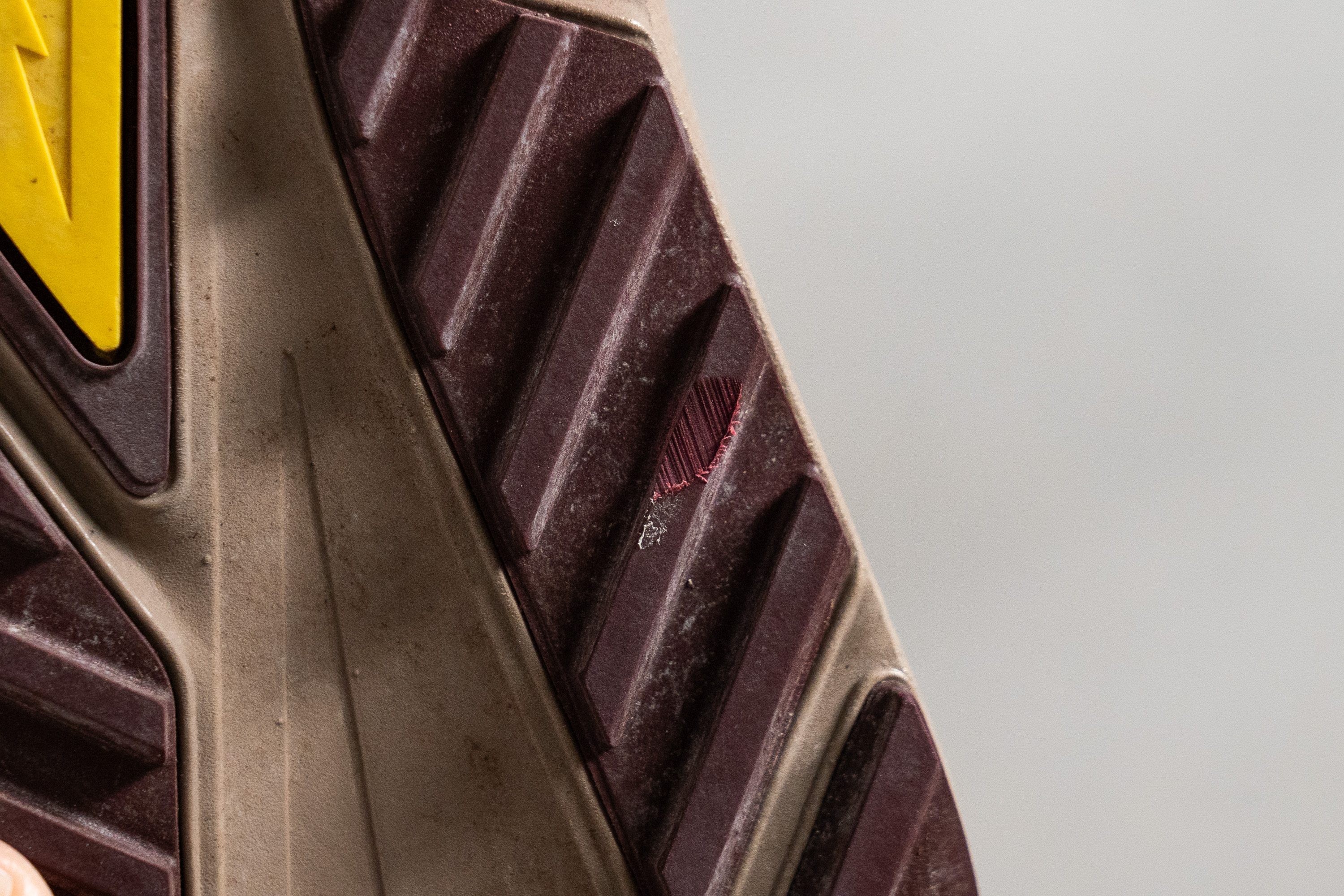
| Pegasus Trail 4 GTX | 0.8 mm |
| Average | 0.9 mm |
Outsole thickness
The outsole might look thin at just 1.0 mm, but it's not a worry for us.
The lugs contribute a substantial amount of rubber and offer average durability, as we've demonstrated before. So, the blend of the outsole and the lugs will definitely provide more than enough durability across all terrains, including roads.
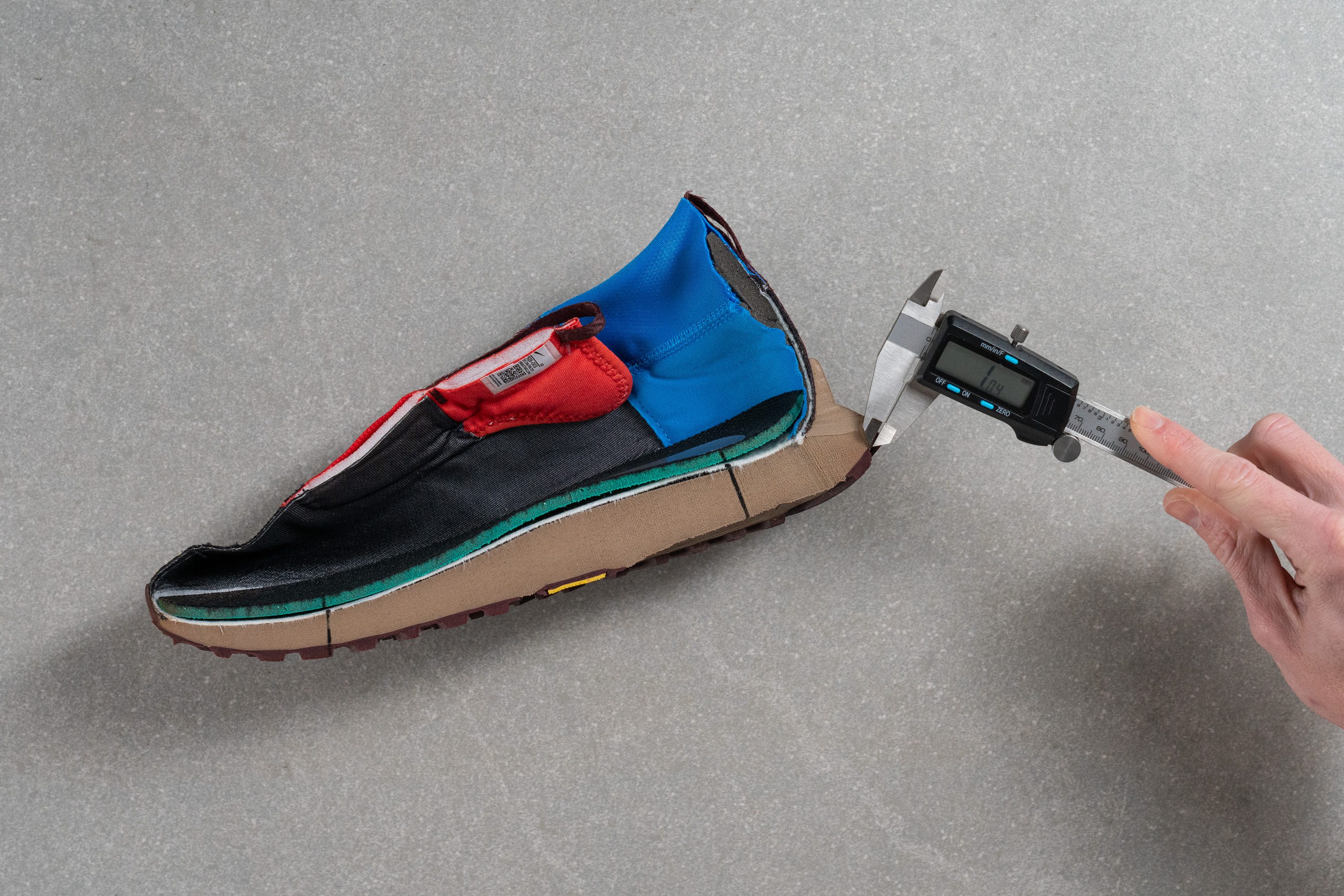
| Pegasus Trail 4 GTX | 1.0 mm |
| Average | 2.2 mm |
Misc
Insole thickness
The insole that comes with the Pegasus Trail 4 GTX is of average thickness at 5.0 mm, maybe a bit thicker than most shoes, but it's not something you'll really notice.

| Pegasus Trail 4 GTX | 5.0 mm |
| Average | 4.7 mm |
Removable insole
The insole in the Peg Trail 4 GTX is removable and pretty straightforward, so we easily swapped in other insoles without issue.
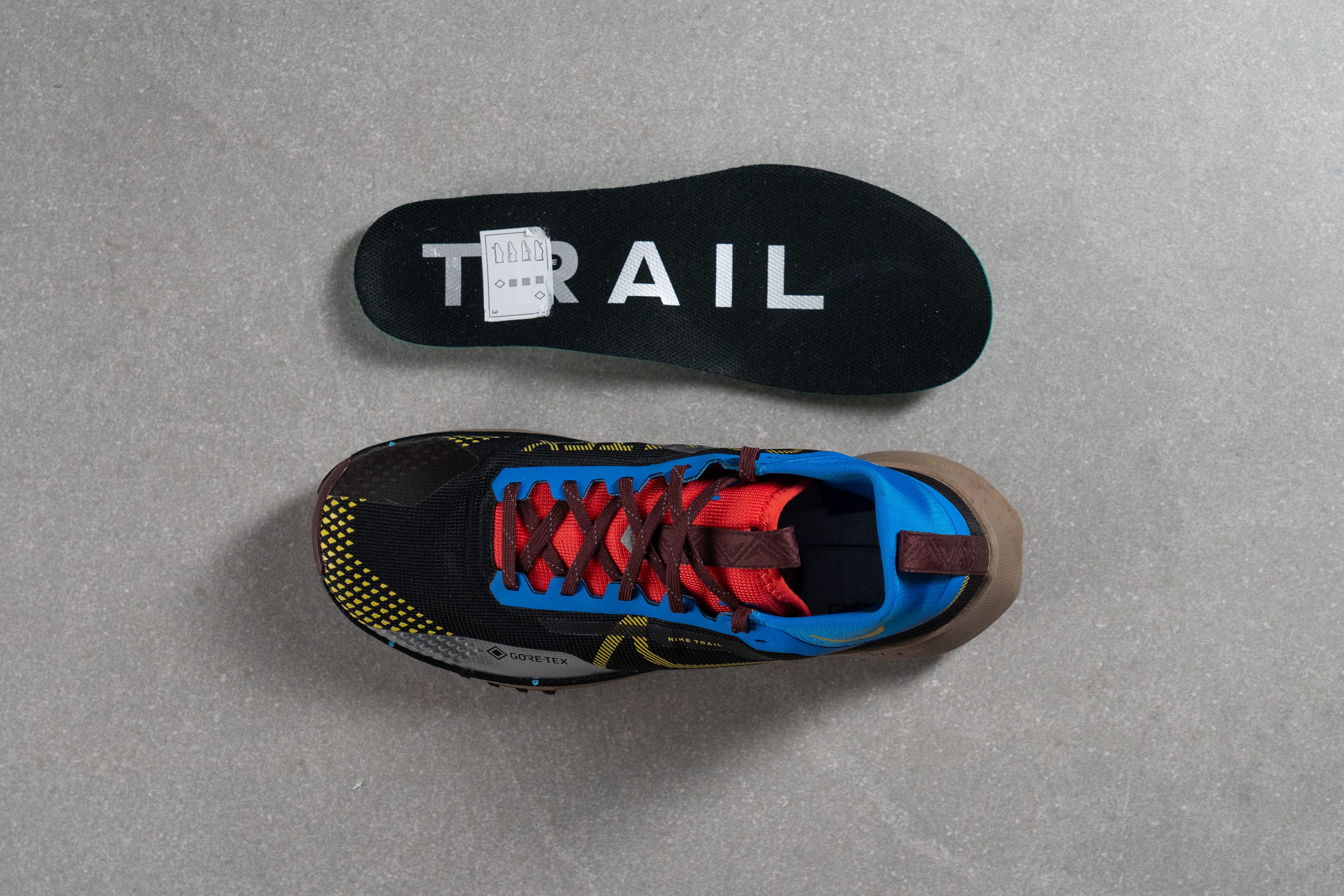
| Pegasus Trail 4 GTX | Yes |
Midsole softness in cold
Most potential users of any Gore-Tex shoe are runners eager to keep training in harsh winter conditions, so performing the freezer test on the Pegasus Trail 4 GTX was crucial for us.
After 20 long minutes, we re-tested it with the Shore A durometer and it delivered a result of 20.9 HA.

| Pegasus Trail 4 GTX | 20.9 HA |
| Average | 27.4 HA |
Midsole softness in cold (%)
That's only a 12.1% increase, a performance that matches up with ZoomX and other world-class, PEBA-based foams on the market, all in a more affordable package!
| Pegasus Trail 4 GTX | 12% |
| Average | 26% |
Reflective elements
As a trail shoe designed for adventures, it was crucial for us that it had reflective elements—and it does have them. However, the reflectivity is quite low, and clearly, Nike could have done a much better job in this area.
| Pegasus Trail 4 GTX | Yes |
Tongue padding
The tongue is not heavily padded, just average at 6.3 mm.

We think this is the right approach—this design works well and we definitely don't want the shoe to add more weight than what's already added by the Gore-Tex membrane.
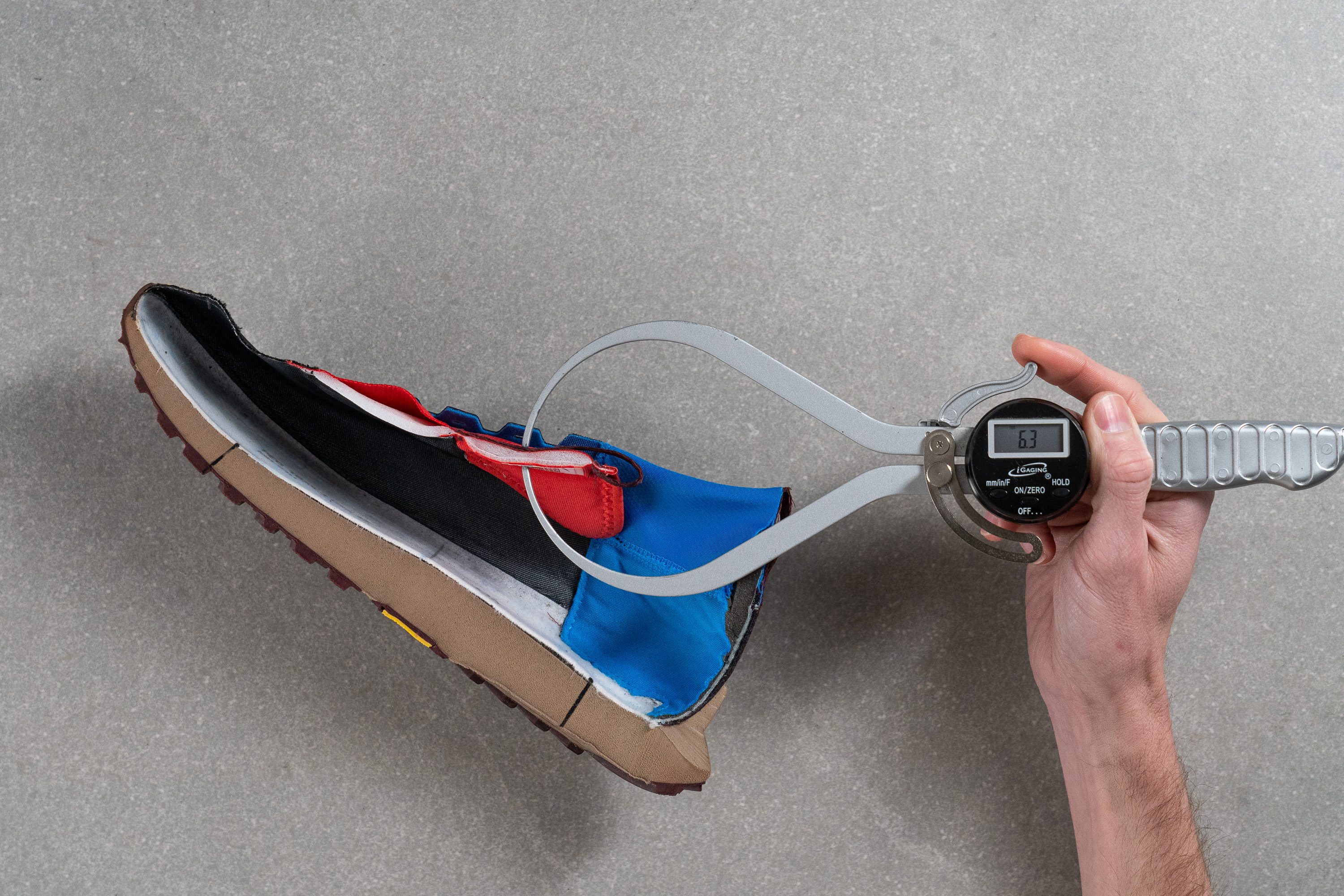
| Pegasus Trail 4 GTX | 6.3 mm |
| Average | 6.4 mm |
Tongue: gusset type
We have a problem here: this is a trail shoe equipped with Gore-Tex, and the tongue isn't gusseted.
This is a big disappointment for us. In a Gore-Tex shoe, where waterproofing is crucial, we believe a fully-gusseted tongue is a must-have. And the same goes for any trail running shoe...
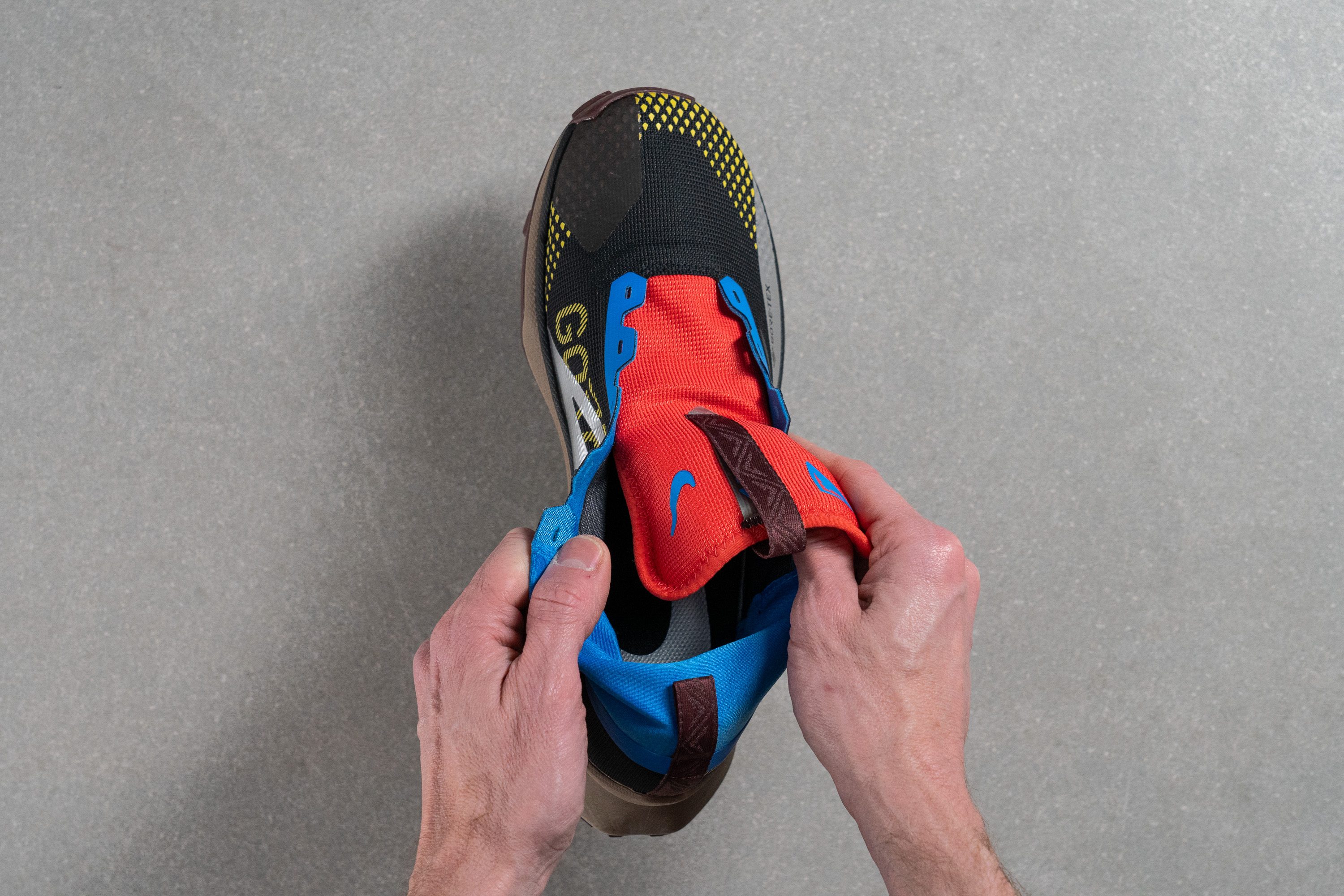
| Pegasus Trail 4 GTX | None |
Heel tab
At the back of the shoe, Nike added a sleek finger-loop heel tab that's seamlessly integrated with the ankle gaiter, and it looks fantastic.
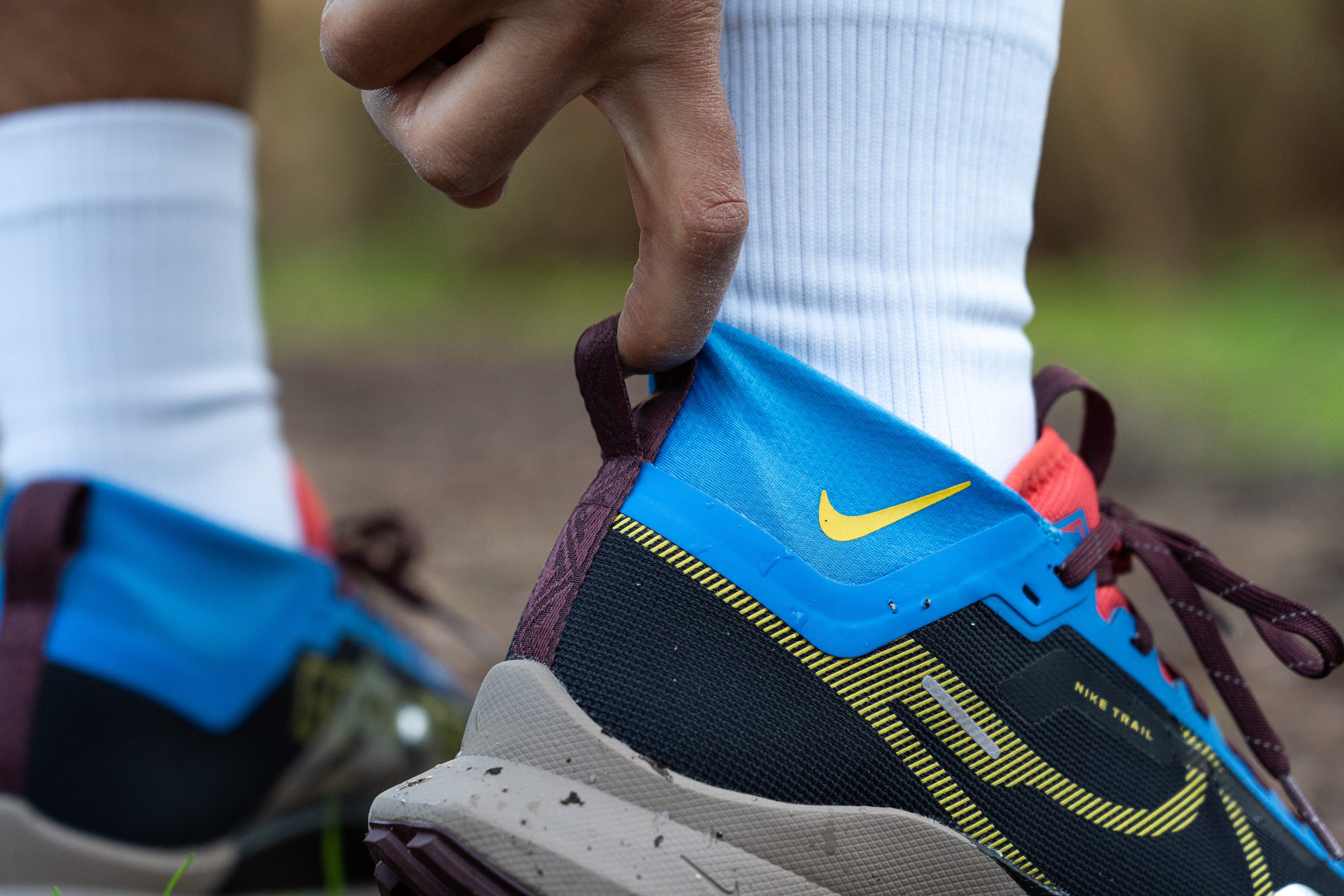
| Pegasus Trail 4 GTX | Finger loop |
























































